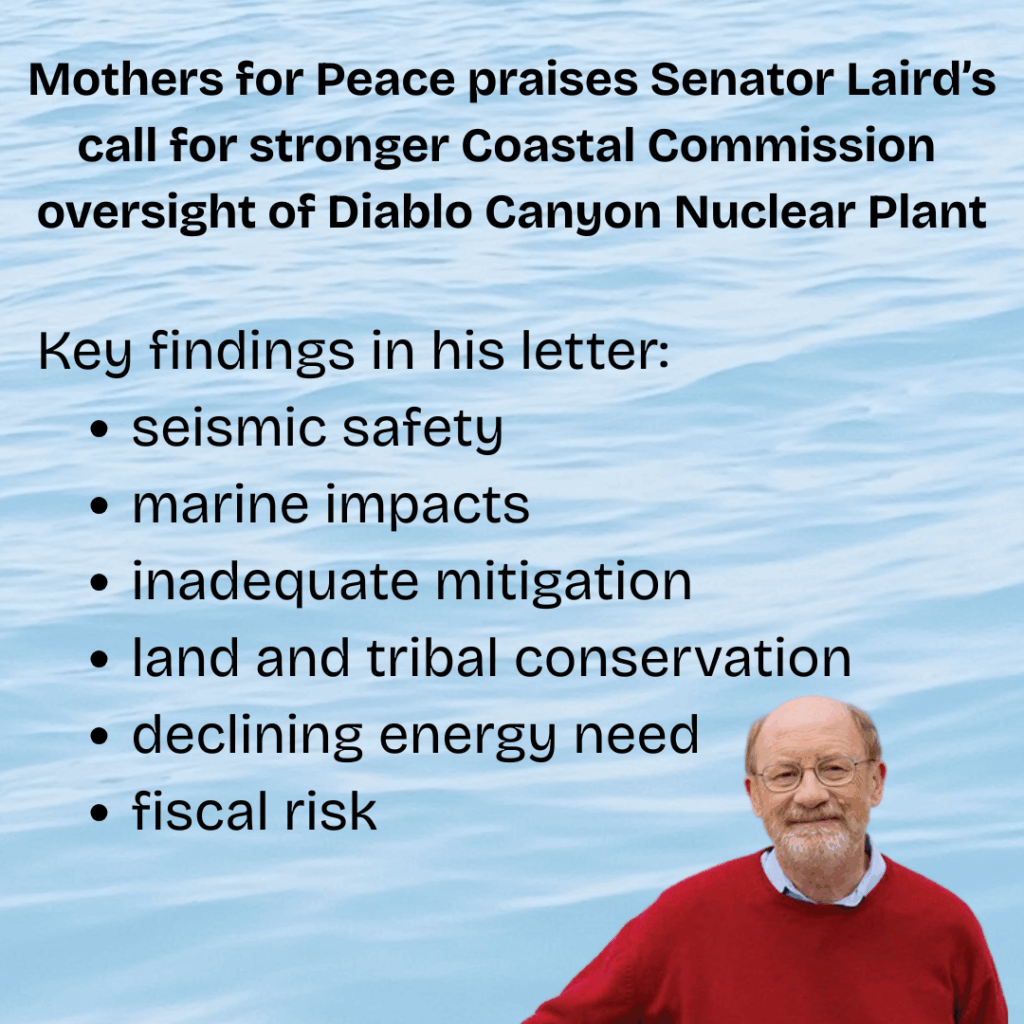Mothers for Peace supports State Senator Laird’s demand for full seismic testing, fiscal transparency, and permanent land conservation before any further operating extension is approved

Mothers for Peace strongly supports California State Senator John Laird’s October 23rd letter to the California Coastal Commission demanding a rigorous, transparent and safety-driven review of PG&E’s application to extend operations at the Diablo Canyon Nuclear Plant.
Laird, who represents the Central Coast and voted in favor of Senate Bill 846 in 2022—the law providing Diablo Canyon a five-year operating extension—warns that the Coastal Commission staff report falls short of state law. His letter argues that the report fails to meet the requirements of SB 846, does not adequately address environmental and safety risks and assumes plant operations beyond 2030—an extension never authorized by the Legislature. Laird calls it an “a premature discussion and perhaps a speculative one.”
“Mothers for Peace fully supports Senator Laird’s position,” said Jane Swanson, MFP spokesperson. “The Coastal Commission has both the authority and the obligation to ensure the highest standards of environmental protection, seismic safety and public accountability before allowing PG&E’s aging reactors to operate even one day longer.”
Key findings in Senator Laird’s letter:
- Seismic safety: Required testing for Unit 1 will not be complete until mid-2026, raising questions about operational safety.
- Fiscal risk: A $300 million gap in PG&E’s state loan repayment could fall on ratepayers already facing steep utility hikes.
- Marine impacts: Diablo’s once-through cooling system kills billions of organisms annually, in conflict with the Coastal Act.
- Inadequate mitigation: The staff’s proposed land conservation offsets would take decades—up to 71 years—to balance just five years of extended operation.
- Land and tribal conservation: Laird urges permanent easements across all 12,000 acres of Diablo Canyon Lands.
- Declining energy need: California has added more than 25,000 megawatts of renewable energy—ten times Diablo’s output—reducing dependence on nuclear power after 2030.
The California Coastal Commission, an independent agency charged with protecting the state’s coast, must ensure any permit to continue operation of Diablo Canyon to 2030, includes comprehensive safety and land-protection measures.
“SB 846 did not suspend the Coastal Act,” said Linda Seeley, spokesperson for Mothers for Peace. “The Commission’s charge is unchanged — require proof of safety, lawful mitigation of marine damage and transparency about who pays the bill.” She added, “Anything short of rigorous seismic review, full-cost accounting, and permanent conservation easements across the Diablo Canyon lands would fail the law and the people of California.”
Diablo power no longer needed
Gov. Gavin Newsom, architect of SB 846, justified extending Diablo Canyon’s life to 2030 as a safeguard against blackouts during extreme heat waves. But that rationale, Laird notes, no longer holds. In the last five years, California has added more than 25,000 megawatts of clean energy—compared to Diablo Canyon’s 2,240 megawatts—making the plant’s output increasingly unnecessary. He also pointed out that State Energy Commission officials have acknowledged in public meetings that Diablo’s power likely won’t be needed beyond 2030 as new solar, wind, geothermal and battery projects come online.
“We applaud Senator Laird’s call for a thorough safety review and his acknowledgment that California no longer needs Diablo Canyon’s costly, polluting power,” said Seeley. “This echoes what we’ve said since SB 846 was rushed through in 2022 — renewables and storage can meet the state’s needs without the risks of an aging nuclear plant.”
“The Coastal Commission must rise to this moment,” Swanson concluded. “The safety of millions of Californians and the integrity of our coastline depend on it.”
